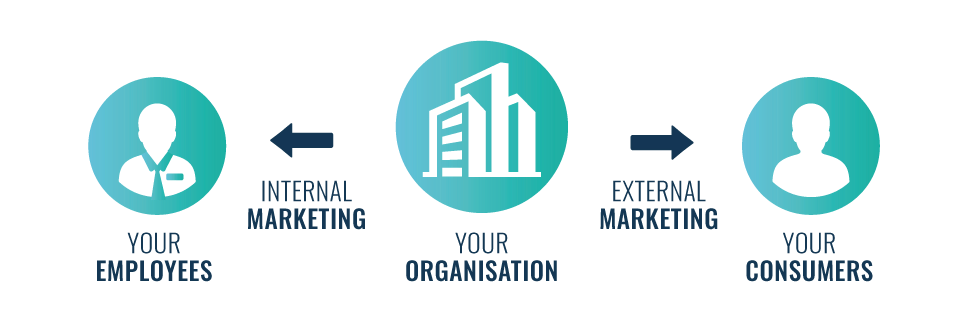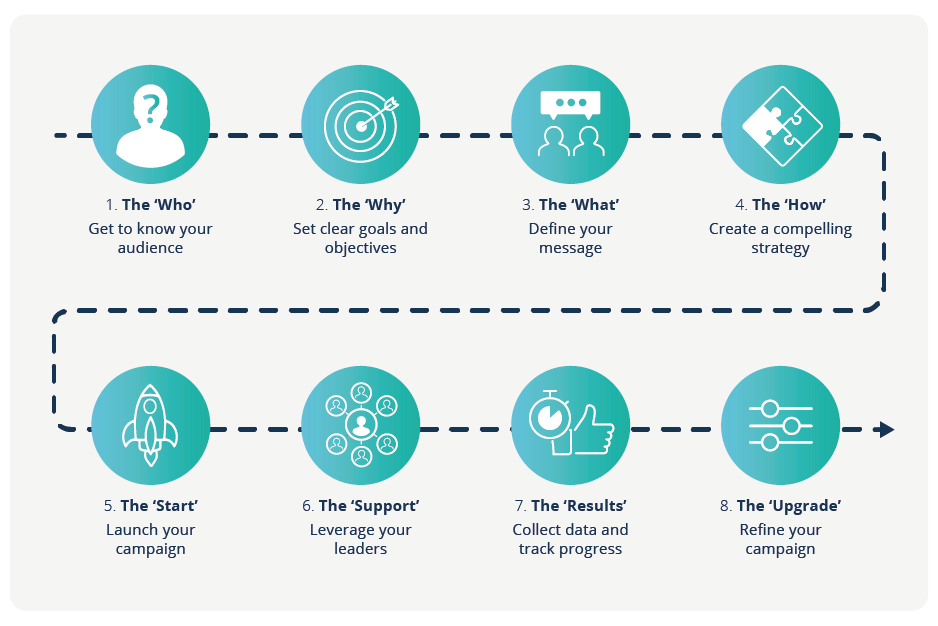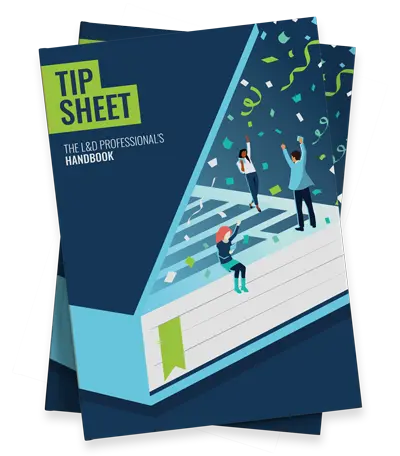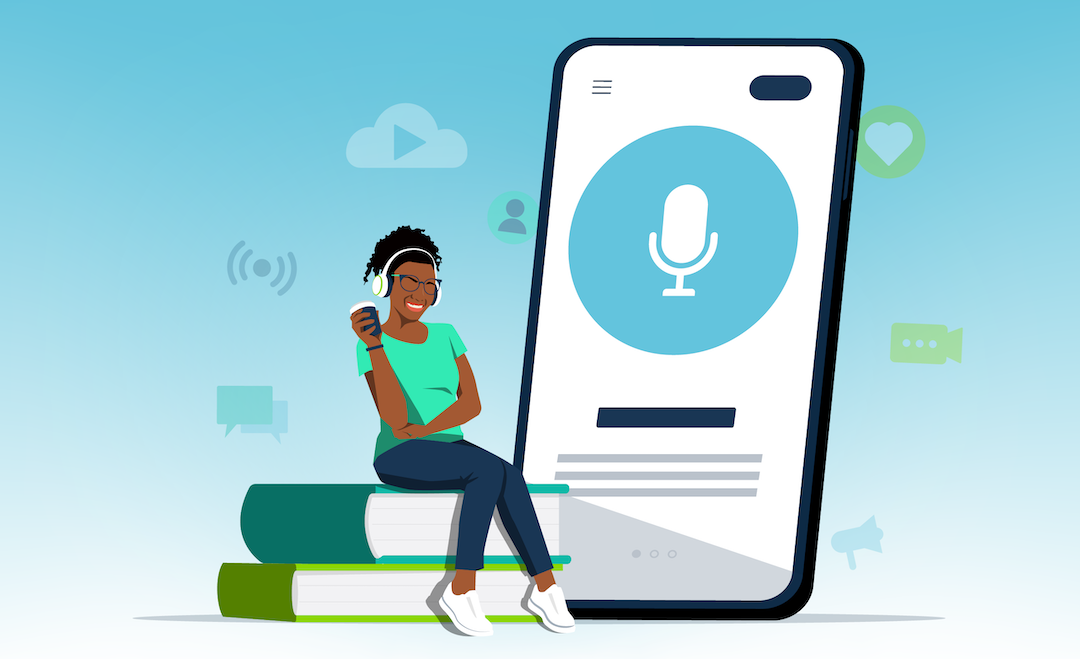
Your training programme might be a thrilling blend of insight and excitement, but that doesn’t mean your learners will flock to it. Unfortunately, your content won’t promote itself. That’s where internal marketing fits in.
Internal marketing (aka. employee marketing) is your means of getting the word out about your learning and development initiatives. This can help to improve uptake and engagement and lead to a better return on your training investment.
And ultimately, isn’t that what we’re all striving for?
Getting started with internal marketing can seem intimidating. As Dr Ian Lings from the University of Technology in Sydney notes: ‘Internal marketing has been discussed in academic literature for decades, yet it remains ill-defined and poorly operationalised’.
Part of the issue is that most learning professionals don’t have a background in marketing. Whilst they may have mastered ADDIE and Bloom’s Taxonomy, concepts like branding, positioning and segmentation may still be shrouded in mystery.
But as we’ll see, this shouldn’t be an impediment to getting started. There are clear steps you can follow and plenty of ideas and tactics that you can ‘borrow’. Ready to take a leaf out of the marketing playbook? Then let’s get started.
What is Internal Marketing?
When you think about the wonderful world of marketing, you probably think of an organisation promoting its solutions and services to its customers. But customers aren’t the only ‘market’ you can target.
Internal marketing shifts your attention towards your workforce. After all, it’s this audience who helps to bring your brand, mission, vision and values to life.

As such, internal marketing refers to the strategies and practices that organisations use to engage and align their employees with their objectives, purpose, culture, products or services.
As the Harvard Business Review notes, internal marketing is ‘the best way to help employees make a powerful emotional connection to the products and services you sell’. And believe it or not, this same connection can be formed with your training programmes.
Why is Internal Marketing Required?

Generating learner engagement is a big challenge. Your employees aren’t sitting around waiting for your next eLearning unit to drop. In fact, research shows that the average employee only has 24 minutes available each week for formal learning.
However, these time constraints don’t tell the full story. Indeed, an Econsultancy report shows that the percentage of employees who say they don’t have time to learn drops from 43% down to 19% if their training plan matches their career goals.
Clearly the issue isn’t a lack of time. The real problem is a lack of alignment. This can be rectified through understanding your learner personas, performing a training needs analysis and internal marketing.
However, everywhere you look there are shortcomings in internal marketing and communication.
- Only 23% of executives say that their companies are ‘excellent’ at aligning employees’ goals with corporate purposes.
- A Gallup study shows that 74% of employees feel like they have missed out on company news due to poor communication.
- And according to Arthur J. Gallagher & Co., 60% of companies don’t have a long-term internal communication strategy in place.
Righting these wrongs can make a real difference. Indeed, McKinsey has found that productivity increases by 20-25% in organisations where employees are well connected.
Moreover, according to a LinkedIn Well-Being Report, employees say that opportunities to learn are the top driver of a great workplace culture. But this culture can only exist if your employees know that your training exists. It’s up to you to get the word out.
The Benefits of Internal Marketing
Marketing focuses on attracting and converting a consumer audience. Naturally enough, this benefits your organisation’s bottom line. Whilst the audience is different, internal marketing also creates tangible benefits for your organisation.
Improved Engagement: This benefit may seem obvious, but it’s worth stating. Internal marketing will lead to more eyeballs on your training content. Furthermore, if your employees feel that they are valued and that their development is a priority, they will be more likely to tackle your training materials with enthusiasm.
Improved Outcomes: If you have higher numbers of learners consuming (and actively engaging with) your training content, then better outcomes and genuine business impact is sure to follow. Furthermore, if your training material itself is good, then you’ll change behaviour, improve performance and increase productivity.
Cost Savings: Producing training content is costly and time-consuming. If you fail to market your learning and development programme effectively, then this effort could all be for nothing. On the other hand, internal marketing helps you to maximise the reach of your training material, ensuring you get bang for your buck.
Your Culture: Prioritising employee development and engagement (and highlighting this focus) can contribute to a positive workplace culture. A culture of learning helps your employees to feel valued, supported and motivated. This is likely to improve employee satisfaction and their general well-being.
Ultimately, internal marketing helps to align your employees with your core values, mission, culture and learning objectives. As we’ve seen, this alignment can have a profound impact on your organisation.
Internal Marketing Challenges
There are some common internal marketing challenges that you should be aware of. For L&D teams, the biggest obstacle is likely to be a lack of resources. Limited budgets, time constraints and inadequate staffing can hamper even the best marketing campaigns.
You may also find that your employees are resistant to change, or unwilling to actively engage with your training programme. Some may be sceptical as to whether this is a good use of their time. After all, they have time constraints of their own to deal with.
You may face further resistance if technology plays a prominent role in your training roll-out. Whilst digital learning solutions are beneficial in a number of ways, less tech-savvy employees may find them challenging.
However, with the right approach, these difficulties can be overcome. To help ensure your success, we’ve created an eight step guide to internally marketing your training initiative. We’ll also share marketing best practice advice and further ideas to get you started.
Your 8 Step Guide to Internal Marketing

1. Get To Know Your Audience (The ‘Who’)

The first step of any good marketing initiative involves getting to know your audience. You’ll need to gather insights about their characteristics, needs and preferences. This is typically an ongoing process that combines data analysis, feedback and communication.
Forging this understanding will make it significantly easier to capture your audience’s attention. To pull this off, we have two recommendations:
- Create and apply learner personas.
- Run a training needs analysis.
Learner personas are fictional representations of your real audience. They’ll help you to understand what makes your learners tick. Likewise, a training needs analysis will help you to understand their existing skill set and their skill gaps.
2. Set Clear Goals & Objectives (The ‘Why’)

Just as learning objectives help to maintain the focus of your training content, your internal marketing campaign requires its own set of objectives. These serve as vital performance indicators, gauging the effectiveness of your approach and its impact.
Make sure these objectives adhere to SMART criteria (Specific, Measurable, Achievable, Relevant and Time-bound). For example, your objective might be to attain a 60% course completion rate for ‘Course X’ among all enrolled learners by the close of Q4.
3. Define Your Message (The ‘What’)

With a clear understanding of your audience and your objectives in place, it’s time to flex your creative muscles. You’ll now need to use these insights to craft a message that resonates with your specific audience.
To create a compelling message, focus on your learners’ specific needs and pain points. Consider how your training materials can effectively remove obstacles, simplify daily tasks, alleviate stress, save time or enhance their earning potential.
Don’t focus on the features of your course or programme. Focus on the benefits. Roll this up into a ‘what’s in it for me’ (WWIFM) statement and you’ll be ready to wow your audience.
4. Create Your Strategy (The ‘How’)

Now that you have a compelling message, you can begin to outline your marketing strategy. This will involve determining your budget and selecting which marketing activities and tactics to indulge in.
If you’re part of an L&D team, it’s likely that most of your budget gets allocated to training production. This leaves you with little left in the pot for promotion. Hiring Wembley Stadium or enlisting Ryan Reynolds as your spokesperson may be out of scope.
This means you’ll have to be selective. You should pick marketing tactics that generate the best possible impact based on the lowest possible investment and effort. We’ve included some ideas and suggestions in the section below.
5. Launch Your Campaign (The ‘Start’)

Once you’ve set your strategy and crafted your marketing materials, you’re ready for action. Select a launch date that is strategic and considerate of your organisation’s calendar.
You’ll probably want to avoid busy times, such as quarter-end or any major holidays. Don’t try to compete with Christmas!
To get things off to a flying start, you should consider organising a launch event or webinar. This event can be used to generate anticipation whilst also helping to set expectations for your learners.
6. Leverage Leadership (The ‘Support’)

Your organisation’s leaders are there to provide vision, direction and motivation. They set the tone for the rest of the workforce. As such, it’s important to seek out their support. Indeed, where possible, you should involve them in your internal marketing campaign.
Their endorsement adds a layer of credibility to your training programme. It signals that your content is relevant and worth investing in. This could be just what your audience needs to encourage them to take action.
7. Track Progress (The ‘Results’)

If you’ve successfully followed the preceding steps, then you should have a set of clearly defined objectives and KPIs guiding your efforts. Indeed, with your internal marketing campaign underway, you can now start monitoring your progress towards these goals.
If you’re using an online learning platform, such as a learning management system or a learning app, then their reporting tools should help you to collect the data you need. You can then conduct an analysis to show whether you’re on the right track.
You may also wish to seek out feedback from your learners. After all, they can provide you with valuable insights about both your training programme and your internal marketing campaign.
8. Refine and Improve (The ‘Upgrade’)

Your data and feedback also serve a second purpose. After all, the fun shouldn’t stop once you’ve rolled out your marketing materials for the first time. You then have the opportunity to refine and iterate based on the feedback you’ve received.
This is your chance to improve your internal marketing campaign. Reflect on potential adjustments to your targeting, key messages and overall strategy. Additionally, consider folding success stories from other learners into your marketing materials.
There you have it. Eight steps for internal marketing success. We also recommend planning for the long-term. If you’ve nurtured a continuous learning culture within your organisation then be ready to sustain it with a consistent calendar of marketing activities.
Embracing Marketing Best Practice
Whether or not you have a marketing background, we would still recommend following the best practice advice listed below. These recommendations are universally applicable and can significantly enhance the effectiveness of your internal marketing campaign.
- Pick the Right Channels: Find your learners where they are. Target the channels where they are most active (for instance: email, social, intranet, events, etc.).
- Be Consistent: Establish a clear brand identity for your training content and marketing material. Ideally, this will be linked to your organisational identity.
- Include Clear CTAs: A call to action provides direction and guidance, making it easier for your learners to understand what’s expected of them.
- Run A/B Tests: Create variations in your campaign and test their impact. This will help you to make decisions based on data rather than assumptions.
- Add a Personal Touch: Where possible use personalisation tags and tailor your messaging. This will ensure your marketing material resonates with your audience.
- Have a Campaign Mindset: Create a content calendar to plan and schedule your marketing campaign. This will ensure a consistent approach.
- Respond Quickly: If your audience has questions relating to your marketing material or training programme, then don’t leave them hanging.
10 Internal Marketing Ideas to Get You Started

With this foundation in place, let’s explore some marketing activities and tactics that can help to move the dial. We’ve shared a variety of ideas below.
Keep in mind that what works for one set of learners might not work for another. You know your audience better than anyone else. As such, you’re best positioned to decide which activities will lead to the best return on investment.
- Get Creative: Your internal marketing campaign is a canvas for unleashing your creative energy. Use teaser emails, posters, podcasts, branded merchandise and social posts to drive your message home.
- Be Bold: Create marketing material that’s eye-catching and appealing. This might include posters, infographics, or brochures that help to highlight the benefits of your training content.
- Use Video: If you really want to capture your learners’ attention, then consider creating a video trailer. According to a recent study, we retain 95% of a message when it’s delivered in video format.
- Create Anticipation: Curiosity is a powerful motivator. Create anticipation by revealing small and enticing details about your training programme in the run up to your launch.
- Start the Clock: Build urgency by incorporating a countdown clock within your marketing material. This lets your learners know when your initiative will launch and helps to create a sense of excitement.
- Internal Networks: Leverage your internal social networks and discussion forums to generate buzz about your training programme. Consider using a relevant hashtag to help spread the word.
- Launch Event: Host an event (virtually or in the real world), to help make the launch of your training programme even more noteworthy. You can celebrate with special announcements, contests and giveaways.
- Gamify The Experience: Reward your learners based on their interaction and engagement. For instance, consuming training content should earn XP, Badges and an improved position on your Leaderboard.
- Share Success Stories: Real life examples often help to inspire others. Seek out ambassadors for your training programme and incorporate their voice within your internal marketing efforts.
- Recognition Awards: If your training programme is ongoing, then consider implementing an annual awards event. This event can be used to highlight your top learners and team players.
Final Word
Marketing has existed for as long as people have bought and sold products. Likewise, the concept of internal marketing has existed for as long as there have been organisations and employees.
Effectively marketing your learning and development programmes to your employees can have a major impact on uptake and engagement. Despite this, internal marketing approaches are often underutilised by learning professionals.
This is primarily due to resource constraints and a lack of awareness. Luckily, this doesn’t have to be the case. There are steps you can follow to create a compelling internal marketing campaign that leverages best practice and is supported by exciting tactics.
It might just be time to don your marketing hat and embark on a journey that promises to engage and delight your employees.
Thank you for reading. Are you a learning professional aiming to enhance their influence? Download ‘The L&D Professional’s Handbook’ now and start making a bigger impact today.









